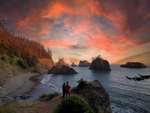The Subway Cave is undoubtedly one of the best hikes in Sedona. The seventy-five foot long, twenty-five foot wide cave rests in a tributary canyon of the larger Boynton Canyon and can easily be accessed with a short, easy going day hike. Contrary to what you'll read elsewhere, finding the Subway Cave is incredibly easy.


Trailhead elevation 4,528'
Water None
Don't Miss Native American directional markers, Sinagua ruins
Hiking to The Subway Cave
First, parking. Trailhead parking is limited to about twenty spots which fill up early. Parking is also permitted along both sides of Boynton Pass Rd, west of the Boyton Pass Rd/Boynton Canyon Rd junction. If you snag a spot at the trailhead parking lot you're looking at roughly a five mile hike. Park along the road and it'll be up to six miles round trip.

On to the hike. If you're using the AllTrails app just follow the Boynton Canyon Trail until you reach the spur trail located on the right side of the main trail two miles from the trailhead. That will lead you to the Subway Cave in about 0.4 miles. It's really that easy. We kind of laugh when we see other websites make claims that it's hard to find the cave or have clickbait titles, like "EXACTLY how to find The Subway Cave." If you look at the screenshot below you'll see that AllTrails shows the spur trail and even notes that there's a cave at the end of it.

The hike to the Subway Cave is average for Sedona standards. There are some great views of towering red rock formations along the right side of the trail, but at least half of the hike to the cave spur trail hugs the Enchantment Resort property line and its sight kind of takes away from the scenery. For most, the destination more than makes up for this. If you're not using the AllTrails app, keep your eyes peeled for the large alligator juniper in the photo below. It'll be on the left side of the trail. Immediately across from it is the spur trail leading you to the Subway Cave.

The spur trail picks up roughly 200' of elevation gain over the course of 0.4 miles. Once you reach the base of the cave, take a loop up and to the left. You'll find a series of Sinagua ruins on the cliffs above. You'll have an opportunity to access them from the cave once you're up there.

To get up into the cave you'll need to scramble up a short, somewhat steep slab of slickrock to get into the cave itself. It's not overly challenging, but the slab is fairly slippery. To the left of the slab you'll find natural stairs which are a bit easier to ascend, but they only go so far and you'll eventually have to get onto the slab.

The slab runs up between the two ledges in the photo below and ends at the back of the cave. When you get to the top and turn around you'll have the view in the photo below.

To access the Sinagua ruins, follow the right ledge out of the cave and along the cliffs for about two hundred feet. You can see them once you turn the corner exiting the cave.

The ledge leading to the ruins isn't terribly narrow, but those with a fear of heights might find some issue here.

When you're done, simply return the way you came. On your way back make sure to keep your eyes peeled for four painted wooden crosses set off from the right side of the trail near the Enchantment Resort property line. We learned that these are directional markers used by Native Americans during ceremonial proceedings.

A few things worth mentioning. This is an incredibly popular hike so you're likely going to have quite a few people in the cave with you. If you're looking for any chance of solitude you'll need to get there as early as possible and even then it's a crapshoot. If you're interested in photographing the cave, you'll have really good lighting and about two hours after sunrise. Since it faces east, the later in the day you get to it, the darker it'll be.
If you're interested in a couple other great day hikes in the area, check out Devil's Bridge and the Birthing Cave.
_edited.png)









































Comments